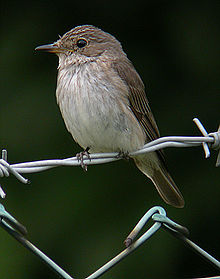- Muscicapa
-
Muscicapa 
Spotted Flycatcher (M. striata) Scientific classification Kingdom: Animalia Phylum: Chordata Class: Aves Order: Passeriformes Family: Muscicapidae Subfamily: Muscicapinae Genus: Muscicapa
Brisson, 1760Diversity About 25 species Muscicapa is a genus of passerine birds belonging to the Old World flycatcher family Muscicapidae, and therein to the typical flycatchers of subfamily Muscicapinae. They are widespread across Europe, Africa and Asia with most species occurring in forest and woodland habitats. Several species are migratory, moving south from Europe and northern Asia for the winter.[1]
They are small birds, 9 to 15 centimetres in length. They have a large head, short tail and a flattened bill, broader at the base. Their plumage is mostly drab brown or grey and rather plain. Young birds tend to be more spotted or mottled.[1]
Muscicapa flycatchers typically feed on flying insects which are caught by sallying out from an exposed perch. The nest is usually cup-shaped and built on a tree branch but some African species nest in tree holes.[1]
Species
23 to 25 different named species of Muscicapa flycatchers are recognized; one putative undescribed species is also known to exist on Sulawesi (Indonesia):[2]
- Spotted Flycatcher, Muscicapa striata
- Gambaga Flycatcher, Muscicapa gambagae
- Grey-streaked Flycatcher or Grey-spotted Flycatcher, Muscicapa griseisticta
- Dark-sided Flycatcher or Siberian Flycatcher, Muscicapa sibirica
- Asian Brown Flycatcher, Muscicapa dauurica
- Brown-streaked Flycatcher, Muscicapa (dauurica) williamsoni
- Ashy-breasted Flycatcher, Muscicapa randi
- Sumba Brown Flycatcher, Muscicapa segregata
- Sulawesi Flycatcher, ?Muscicapa sp.[3]
- Rusty-tailed Flycatcher, Muscicapa ruficauda
- Brown-breasted Flycatcher, Muscicapa muttui
- Ferruginous Flycatcher, Muscicapa ferruginea
- Ussher's Flycatcher, Muscicapa ussheri
- Sooty Flycatcher, Muscicapa infuscata
- Boehm's Flycatcher, Muscicapa boehmi
- Swamp Flycatcher, Muscicapa aquatica
- Olivaceous Flycatcher, Muscicapa olivascens
- Chapin's Flycatcher, Muscicapa lendu
- Itombwe Flycatcher, Muscicapa (lendu) itombwensis
- African Dusky Flycatcher, Muscicapa adusta
- Little Grey Flycatcher, Muscicapa epulata
- Yellow-footed Flycatcher, Muscicapa sethsmithi
- Dusky-blue Flycatcher, Muscicapa comitata
- Tessmann's Flycatcher, Muscicapa tessmanni
- Cassin's Flycatcher, Muscicapa cassini
- Ashy Flycatcher, Muscicapa caerulescens
Footnotes
References
- del Hoyo, Josep; Elliott, Andrew & Sargatal, Jordi (eds.) (2006): Handbook of Birds of the World (Vol. 11: Old World Flycatchers to Old World Warblers). Lynx Edicions, Barcelona. ISBN 84-96553-06-X (Vol.11: 2006)
- King, Ben; Rostron, Philip; Luijendijk, Teus; Bouwman, Rob & Quispel, Chris (1999): An undescribed Muscicapa flycatcher on Sulawesi, Indonesia. Forktail 15: 104. PDF fulltext
- Perrins, Christopher (ed.) (2004): The New Encyclopedia of Birds. Oxford University Press, Oxford. ISBN 0198525060
- Sinclair, Ian; Ryan, Pete; Christy, Patrice & Hockey, Phil (2003): Birds of Africa: a complete illustrated field guide to the birds of the Sahara. Struik, Cape Town. ISBN 1-86872-857-9

This article about an Old World flycatcher is a stub. You can help Wikipedia by expanding it.
